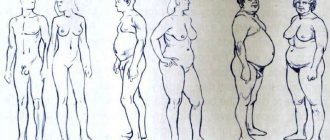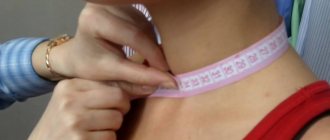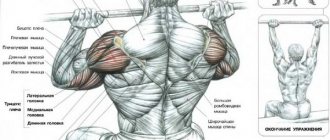If you don’t know how to take shoulder measurements in order to choose the right clothes on Aliexpress, read the article. It contains size charts and instructions for taking measurements.
Most of the orders on Aliexpress are clothes of various types. On this trading platform you can find clothes for all occasions - inexpensive, high-quality, for any season, from different brands and fashionable. But to buy the right thing, you need to choose the right size. From this article you will learn how to take shoulder measurements to calculate clothing size on Aliexpress .
Main anthropometric points
When measuring a female figure, the following points are used to construct patterns:
- apical - the highest point of the crown;
- cervical - the apex of the spinous process of the seventh cervical vertebra;
- the point of the base of the neck is the intersection of the neck girth line with a conventional vertical plane cutting the shoulder slope in half;
- clavicular - the highest point of the sternal end of the clavicle;
- humeral - the point at the intersection of the superior outer edge of the acromion process of the scapula with a conventional vertical plane cutting the area of the shoulder joint in half;
- humeral acromial - the most protruding point of the acromial process of the scapula;
- radial - the upper point of the head of the radial bone;
- upper sternal - a point in the deepening of the jugular notch of the sternum;
- midsternal - a point in the middle of the chest line at the level of the articulation of the cartilages of the fourth ribs with the sternum;
- nipple - the most protruding point of the mammary gland;
- patella - center of the kneecap;
- the anterior angle of the axilla is the highest point of the arc formed by the anterior edge of the axilla with the arm lowered;
- posterior angle of the axilla - the highest point of the arc formed by the posterior edge of the axilla with the arm lowered;
- gluteal - the most protruding point of the buttock;
- waistline height point - a point on the most depressed part of the lateral surface of the body, midway between the lower rib and the iliac crest.
Constructive belts for the female figure
- Head: taken into account when modeling hats and clothing covering the head.
- Neck: determines the position of the neckline on the pattern. It is very important when constructing collars and necks of products.
- Shoulder: taken into account when constructing shoulder patterns for figures with different posture, shape and rotation of the shoulders. It determines the overall width of the garment at the shoulders.
- Chest: taken into account when determining the width of clothing and constructing the back and front of products.
- Waist: taken into account when determining the width of the product along the waist line.
- Pelvic: taken into account when determining the volume, width and division of clothing at a given level of the figure.
- Thigh: taken into account when determining the volume and width of products at this level, especially waist ones (trousers, shorts, skirts, swimsuits).
- Knee: taken into account when determining the length of the product.
- Calf: taken into account when choosing the volume and width of the bottom of both waist and shoulder products.
- Forearms: determine the volume, width and length of the sleeves and are very important when designing the collar, bottom and elbow part of the sleeve.
When constructing waist products, the main dimensional characteristic is the circumference of the hips. When constructing shoulder products - chest girth.
Separate parameter
These are the three main parameters that are the keys to how to measure your shoulders correctly. But there is an additional aspect that does not require a measuring tape, because it must be measured visually. This is the tilt of the shoulders. This parameter has only three values, but it can greatly affect the process of sewing clothes. In this case, it doesn't take a genius to figure out how to measure your shoulders and their slope. It is enough just to know that the standard degree at which they are located is somewhere between 20 and 25. Such numbers are considered normal, while a larger angle means sloping shoulders, and a smaller angle means square. This parameter should also be taken into account when choosing clothes remotely or when sewing them yourself.
Symbols of measurements
Measurements (dimensional characteristics) are designated by the following letters:
- girths - O;
- half-girths - C;
- width - W;
- lengths, distances, arcs - D;
- height - B;
- height (body length) - P;
- the distance between centers or protruding points - C;
- diameters - d4;
- depth - G;
- body position - P.
Small letters or numbers to the right of capital letters indicate measurement locations.
Measurements of girths, lengths, heights, as well as the width of the shoulder slope are recorded in full size, measurements of half-girths of widths, distances between centers - in half size (Ssh, St, Sb, Shs, Shg, Tsg).
All measurements are recorded in centimeters.
How to correctly take measurements of a woman's figure
To obtain accurate results, follow simple rules when taking measurements:
Take measurements while wearing tight-fitting clothing or underwear that is intended to be worn under the product. After all, corrective underwear can slim your figure, removing 1-3 cm of volume, while a bra, on the contrary, can add volume.
When taking measurements, stand upright, keeping your back straight, without slouching. Place your arms down and don't bend your legs.
There is no need to specifically reach out like a sprout to the sun. Stand straight, but in your usual position.
Tie a cord or rope around your waist - this will make it easier to take measurements related to the waist line.
Apply the measuring tape tightly to the body, without pulling, but also without relaxing.
All measurements of a female figure are taken from the right side of the body.
To take the most important measurements that form the balance of the product, it is convenient to use the shoulder pad.
All dimensional characteristics are divided into transverse and longitudinal. A complete list of measurements for clothing design can include up to 70 measurements. Some of them are calculated by subtraction.
To determine half girths, measure the full girth and divide the result by 2.
Some measurements begin to be taken from the seventh cervical vertebra . Finding it is simple: tilt your head downwards, and where the neck meets the torso, feel the most protruding tubercle. This is the seventh cervical vertebra.
we recommend
The name of the measurements and their measurement lines
1. Chest girth (Og) - at the most protruding points of the chest.
2. Center of the chest (CH) - measured between the protruding points of the mammary glands. The tape lies horizontally.
3. Waist circumference (From) - at the narrowest point at the waist.
4. Hip circumference (H) - at the most protruding points of the buttocks.
5. Second hip girth - measured just below the buttocks along the protruding parts of the “breeches” (fat deposits on the outer side of the thigh). If this measurement is larger than the circumference of the hips, then when creating patterns it is used, especially for products with an adjacent silhouette.
6. Hip height (Wb) - measured from the side from the waist line to the hip line.
7. Chest height (Вг) - from the point of transition of the neck to the shoulder (base of the neck) to the most protruding point of the chest.
8. Length to the front waist (FW) - from the base of the neck through the most protruding point of the chest to the waist line.
9. Neck circumference (Osh) - measured at the base of the neck.
10. Height of the shoulder oblique front (Vpkp) - from the point of intersection of the sagittal of the figure with the waist line of the front to the extreme point of the shoulder.
11. Oblique shoulder height (HHH) - along the back from the point of the spine at the waist line to the extreme shoulder point.
12. Length to the waist along the back (Dts1) - from the seventh cervical vertebra to the waist line.
13. Back width (Ws) - measured horizontally through the center of the shoulder blades between the rear corners of the armpits.
14. Length to the waist along the back, taking into account height (Dts2) - from the base of the neck to the waist line.
15. Shoulder length (Ll) - from the base of the neck to the point of articulation of the shoulder with the arm.
16. Product length (Di) - for shoulder products, measure from the seventh cervical vertebra to the desired length.
17. Knee length (Ktk) - from the point at the waist to the middle of the knee.
18. Armhole depth (D) - from the seventh cervical vertebra to the vertical line that runs from the posterior corner of the armpit to the middle of the back. To measure, you can hold a strip of paper 4 centimeters wide under your arm, reaching up to your spine.
19. Armhole width (Armhole) - a strip of paper is held horizontally under the armpit and a marker is used to mark the vertical stripes on both sides of the arm. The length of the resulting segment on paper is the required measurement.
20. Sleeve length (Dr) - along the arm slightly bent at the elbow from the end of the shoulder to the wrist.
21. Shoulder circumference (Op) - measured horizontally along the widest upper part of the arm.
22. Wrist circumference (Oz) - around the base of the hand along the bone.
23. Seat height (S) - measured while sitting on a hard, flat surface, from the back from the waist line to the seat level.
24. Arc through the groin area (Dp.ob) - measured between the legs from the waist line in front to the waist line in the back.
25. Arc of the torso through the groin area (DTp.ob) - from the back from the seventh cervical vertebra to the waist line; from the back waistline through the groin to the front waistline; from the front waistline to the base of the neck. The resulting three values are added together.
26. Front shoulder height (FSH) - from the point of articulation of the shoulder with the arm to the most protruding point of the chest.
27. Girth above the chest (Og1) - horizontally above the base of the chest.
28. Second chest width (W2) - measured through the high points of the chest between the front corners of the armpits. Recorded at half size.
29. Girth under the chest (Og3) - horizontally under the base of the chest.
30. Front length (FB) - from the point at the waist along the protruding part of the abdomen to the floor.
31. Side length (DSL) - from the point at the waist along the protruding part of the hip to the floor.
32. Shoulder width (W) - horizontally between the extreme points of the shoulders.
33. Overall length of the product (Di) - from the back from the seventh cervical vertebra along the spine through the waist line to the desired length.
34. Thigh circumference (Lunch) - at the widest point of the leg, slightly below the subgluteal fold.
35. Leg circumference (He) - measured 10 centimeters above the knee.
36. Knee circumference (OK) - horizontally around the knee.
37. Calf girth (Gi) - horizontally at the widest part of the calf muscle.
38. Ankle circumference (Osh) - horizontally along the thinnest place at the bottom of the leg.
39. Length at the back (Dsz) - from the point at the waist along the protruding part of the buttocks and to the floor.
40. Skirt length (Du) - from the back from the waist line along the most protruding point of the hip to the desired length.
41. Step length (Lsh) - from the groin along the inside of the leg to the floor level, with legs slightly apart.
42. Height (Dt) - distance from the apical point to the floor.
43. First chest width (Shg 1) - measured above the base of the mammary glands between vertical lines drawn up from the front corners of the armpits. The tape should lie horizontally directly above the girth line above the chest. Recorded at half size.
44. Half-chest girth first (PoG1) - measured horizontally through the convex places of the shoulder blades and above the mammary glands.
45. Second half-chest girth (PoG2) - measured horizontally through the convex places of the shoulder blades and along the high points of the chest.
The first and second half-circumferences of the chest are measured strictly one after the other; the position of the measuring tape should only change on the front of the chest. The results are recorded divided in half.
46. Body position (Pc) - measured horizontally from the cervical point to the vertical plane touching the most posteriorly protruding points of the shoulder blades. This is a measure of posture.
47. Waist depth first (Gt1) - measure the horizontal distance from the vertical plane touching the protruding points of the shoulder blades to a ruler applied horizontally to the longitudinal muscles of the back at the level of the waist line.
48. Second waist depth (Gt2) - measure the horizontal distance from the vertical plane touching the buttock points to a ruler applied horizontally to the longitudinal muscles of the back at waist level.
49. Length of the back to the waist, taking into account the protruding shoulder blades (Lts) - measured from the waist line to the cervical point along the spine through a thin plate up to 2 centimeters wide, superimposed on the protruding points of the shoulder blades.
50. Height of the neck point (Vsht) - the distance from the floor to the neck point.
51. Head height (Height) - determined by subtracting the height of the cervical point from height (Dt).
52. Height of the point of the base of the neck (Vtosh) - the distance from the floor to the point of the base of the neck.
53. The height of the shoulder point (Vpt) is the distance from the floor to the shoulder point.
54. The height of the clavicular point (Vkt) is the distance from the floor to the clavicular point.
55. Height of the knee point (Vkt) - the distance from the floor to the knee point.
56. Height of the posterior angle of the axilla (Vzu) - the distance from the floor to the posterior angle of the axilla.
57. The height of the subgluteal fold (HS) is the distance from the floor to the middle of the subgluteal fold.
58. Arc through the highest point of the shoulder joint (AP) - measured vertically from the level of the posterior angle of the axilla through the highest point of the shoulder joint to the level under the anterior angle of the axilla.
59. Vertical diameter of the arm (dvr) - determined by subtracting the height of the posterior angle of the armpit from the height of the shoulder point.
60. Head circumference (Ogol) - measured through the most protruding point of the back of the head and the center of the forehead.
61. Hand girth (Okis) - measured perpendicular to the axis of the hand through the metacarpophalangeal joint of the first finger, which should be 30-35 degrees away from the second.
62. Bent knee circumference (Ox) - measure the leg, bent at the knee at a right angle, along the popliteal fossa through the knee point.
63. Instep circumference (Oc) - through the back most protruding point of the heel and the highest point of the instep. The tape closes at the front.
64. Length of the arm to the elbow (Dr.lok) - the distance from the shoulder to the radial point.
65. Half waist circumference (St) - half the waist circumference measurement.
66. Half-girth of the hips, taking into account the protruding abdomen (Sb) - at the buttock points, horizontally around the body along the protruding abdomen. The resulting value is recorded by dividing by 2.
67. Half-girth of the hips without taking into account the protruding abdomen (Sb1) - along the buttock points horizontally around the body. The resulting value is recorded by dividing by 2.
68. Neck half-girth (Ssh) - a measuring tape with the lower edge is placed above the cervical point; from the side and in front, the tape passes along the base of the neck, touching the clavicular points with the lower edge and closing above the jugular cavity. The result obtained is divided in half.
69. Transverse diameter of the neck (dsh) - between the points of the base of the neck.
70. Shoulder diameter (dп) - measured from the front between the shoulder points.
It is convenient to record the measurements taken in a table, where half and quarter values will then be calculated. An example of such a table is presented below.
| Measure | Meaning | 1/2 measure | 1/4 measure |
| Waist circumference | |||
| Hip girth | |||
| … |
It is very important to analyze the figure: determine the type of posture and body features .
There are three types of posture:
- normal
- stooped
- kinky
A stooped figure by a convex back, a greater tilt of the neck forward and a lesser bend in the waist from the back. The shoulders are also tilted slightly forward.
A curved figure has the opposite: the neck is straighter, the back is straight and there is a large deflection at the waist. The shoulders are pulled back and the chest is more prominent.
The type of posture can be assessed not only visually, but also by the following measurements:
- Front length to waist (Lts);
- Back length to waist (Dtp);
- Half chest circumference 1 (PoG1);
- Half chest circumference 2 (PoG2);
These measurements need to be compared: find the difference in lengths and half-circumferences.
Rdt=Dtp-Dts
Рсг=Сг2-Сг1
Calculating posture:
Os=Rdt-Rsg+2.5cm
We get the result:
- Os=0 - normal posture
- Os with a negative value - stooped posture
- Os with a positive value - kinked posture
Types of posture are always taken into account when creating a basic pattern.
In addition to analyzing the figure, it is also recommended to compare measurements: chest width first (Wg1) and chest width second (Wg2), half chest girth first (Cr1) and half chest girth second (Cr2). Calculations are made using the formula:
Shg2=Shg1+(Cr2-Cr1)
The resulting number should be equal to the second chest width measurement taken from the figure. If this equality does not work out, then it is necessary to check all four measurements, that is, retake them.
Shoulder length measurement
Another parameter that may be useful to you is the length of the shoulder. Given the fact that there is also a neck between one shoulder and the other, you will not be able to divide the width of the shoulders in half to get each indicator separately. Therefore, a separate measure was introduced - shoulder length. It is measured from the base of the neck to the end of the shoulder, and again it is best to take several measurements to ensure that you get a more accurate figure and do not make mistakes. In clothing, the shoulder length may differ from your anatomical parameters - it depends on how exactly you want to sew the item of clothing.
Table of measurements for typical female figures
If you need measurements taken from you, but there is no one to help you with the measurements, you can independently measure only the chest girth (for shoulder products) and use it to determine your size in the table of women's measurements for a conventionally typical figure. And use standard measurements for size. For waist products, measure the circumference of your hips, according to which you select the appropriate size and appropriate measurements.
| Measurement value | ||||||
| Size | 40 | 42 | 44 | 46 | 48 | 50 |
| Transverse dimensional characteristics | ||||||
| Bust | 80 | 84 | 88 | 92 | 96 | 100 |
| Waist circumference | 60 | 64 | 68 | 72 | 76 | 80 |
| Hip circumference (20 cm below the waist line) | 86 | 90 | 94 | 98 | 102 | 106 |
| Hip circumference (10 cm below the waist line) | 80 | 84 | 88 | 92 | 96 | 100 |
| Back width | 34 | 35 | 36 | 37 | 38 | 39 |
| Chest Width | 31,5 | 32,5 | 33,5 | 34,5 | 35,5 | 36,5 |
| Shoulder width | 12,4 | 12,7 | 13 | 13,3 | 13,6 | 13,9 |
| Distance between chest centers | 16,8 | 18 | 19,2 | 20,4 | 21,6 | 22,8 |
| Neck circumference | 35,5 | 36,5 | 37,5 | 38,5 | 39,5 | 40,5 |
| Circumference above the chest | 74 | 78 | 82 | 86 | 90 | 94 |
| Underbust circumference | 67 | 71 | 75 | 79 | 83 | 87 |
| Shoulder circumference | 26 | 27 | 28 | 29 | 30 | 31 |
| Elbow circumference | 22,2 | 23,6 | 25 | 26,4 | 27,8 | 29,2 |
| Wrist circumference | 15 | 15,5 | 16 | 16,5 | 17 | 17,5 |
| Hip circumference | 48 | 51 | 54 | 57 | 60 | 63 |
| Knee circumference | 32,2 | 33,6 | 35 | 36,4 | 37,8 | 39,2 |
| Ankle circumference | 21,8 | 22,4 | 23 | 23,6 | 24,2 | 24,8 |
| Longitudinal dimensional characteristics | ||||||
| Height | 159 | 161,5 | 164 | 166,5 | 169 | 171,5 |
| Back length from the level of the seventh cervical vertebra to the waist line | 40 | 40,5 | 41 | 41,5 | 42 | 42,5 |
| Back height from the level of the seventh cervical vertebra to the chest line | 24 | 24,2 | 24,4 | 24,6 | 24,8 | 25 |
| Armhole height | 21 | 21,2 | 21,4 | 21,6 | 21,8 | 22 |
| Chest height | 33,5 | 34 | 34,5 | 35 | 35,5 | 36 |
| Hips height from waist to hips | 19,4 | 19,7 | 20 | 20,3 | 20,6 | 20,9 |
| Arm length | 56,4 | 57,2 | 58 | 59,6 | 60,4 | 61,2 |
| Seat length | 26,4 | 27,2 | 28 | 28,8 | 29,6 | 30,4 |
| Arc through the groin area | 61 | 63,5 | 66 | 68,5 | 71 | 73,5 |
| Arc of the torso through the groin area | 136,5 | 140 | 143,5 | 147 | 150,5 | 154 |
| Distance from waist to knee | 58,4 | 59,2 | 60 | 60,8 | 61,6 | 62,4 |
| Distance from waist to floor | 100,4 | 101,7 | 103 | 104,3 | 105,6 | 106,9 |
| Distance from the seventh cervical vertebra to the floor | 140,4 | 142,2 | 144 | 145,8 | 147,6 | 149,4 |
After all the necessary measurements have been taken, calculations are made and allowances are added for the freedom of fit. Then they move on to constructing the basic pattern.
sew-myself —— cutting and sewing
Subscribe to “SEW-MYSELF.ru” on social networks to always be aware of new articles!
Follow @sew_myself
How to measure shoulder width correctly?
To protect his body from the negative effects of the external environment, insect bites, harmful substances and other factors, ancient man invented clothing. Over time, it underwent various changes, becoming more convenient and functional. Certain elements of clothing became an expression of national characteristics and acquired cultural and social significance.
The design and tailoring of clothing has grown into an art form, separated into a separate direction called fashion. Fashion designers are engaged in the development of various forms of clothing. The better a master is able to embody new fashion trends, while creating his own unique style, the higher public appreciation he receives. Creating high-quality models requires from a fashion designer, in addition to the obligatory talent, great hard work, obsession and patience.
The concept of “tailoring” comes from the French word tailler, which translates as “to make to measure.” In essence, cutting is a certain order of necessary actions that allow you to create patterns for various clothing models.
In order to correctly construct a drawing of the future product, the necessary measurements should be made. When mass producing models, template data for typical figures is used. In custom tailoring, it is very important to take correct measurements. A professional cutter should know well how to measure shoulder width, chest volume, product length and other parameters. The procedure for taking measurements should be treated with great responsibility, since the final result depends on the correctness of the actions and the accuracy of the measurements. The process seems quite simple, but to know, for example, how to correctly measure shoulder width or sleeve length, you need basic knowledge of the anatomical structure of the body, ideas about body types, and human constitution.
Peculiarities
The human physique is a combination of several parameters: the size of the torso, the shape of the torso, the proportions of individual parts of the body and the physiological characteristics of the structure of the tissues of the human body. The concept of “physique” is rather a medical term. In everyday life, fitness, physical education, modeling and tailoring, the most common term is “figure”. Within the framework of the constitution, each person has his own individual figure, which is determined long before his birth. It depends only on the parental genes what the future child’s height, shoulder width, and foot size will be. Due to the huge variety of hereditary factors, no one can predict what body features a person will inherit. The figure is also influenced by gender, profession, and sports activities.
The process itself
When starting to take parameters, you should know exactly what measurements are required. In order to sew a men's shirt, you need to know how to measure shoulder width, sleeve length, neck circumference and product length. Tailor's measuring tools can help with this.
The measuring tape was invented by a French tailor back in the early nineteenth century. It is a narrow strip of durable material one and a half meters long with metal clips at the ends. A graduation scale is applied on both sides of the tape. To avoid inaccuracies in taking measurements, it is advisable to use the same tool when sewing a product.
Abbreviation
The obtained data must be entered into the measurement table using special notations. Capital letters indicate the names of the measurements, and small letters indicate the measurement point. O - girth, H - height, W - width, D - length, t - waist, b - hips and so on. So, shoulder width. This measure is designated as follows: Shp.
When taking measurements, the customer must be wearing the shoes in which he will wear the clothes being made. The height of the heel affects not only the length of the product, but also the curves of the figure. The person should stand straight, without moving, in a relaxed and calm state. It is better if he wears only underwear or thin, tight clothing.
Advice
When taking basic measurements, it may be difficult to figure out how to measure shoulder width. The accuracy and correctness of sizing affects the fit of the product.
The width is measured horizontally by connecting the extreme points protruding above the shoulder joints. The tape should fit snugly to the body, but not be tight.
We take measurements ourselves
If a tailor sews clothes for himself, then he can take most of the measurements himself. But the question inevitably arises: how to measure shoulder width without outside help? To do this, you can take your own shirt or T-shirt that fits perfectly on your shoulders, then straighten it on the table and use a tape to measure the distance between the points where the sleeve joins the shoulder line. This way you can take the correct measurement.











